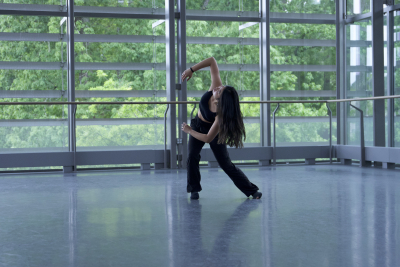Divergent Thinking by Dint of Dance

Florence Wang graduated this past May with dual degrees in Statistical Science and Neuroscience and minors in Chemistry and Dance. Immersed in STEM throughout her time at Duke, she enhanced her course loads by adding quantitative statistical and life science classes.
“That additional coursework really helped me gain a better understanding of the neural mechanisms behind how humans think,” she explains.
During her senior year, she added a research assistant position at the Center for Cognitive Neuroscience, where she was part of a team that worked on a fractal norming study, investigating the relationship between emotions and decision making.
“I was able to use statistical and technological methods during my research experience, allowing me to home in on both my passions: statistics and neuroscience,” she says.
Adding a Dance minor was a natural way to nurture her ballet career, which began as a three-year-old at the University of South Carolina Dance Conservatory and continued throughout her time at Duke.
As an undergraduate, she cofounded Embodiment Contemporary Dance, the first contemporary student dance group on campus, and was a member of the multicultural student dance group Defining Movement.
We sat down with Wang to talk about what brought her to Duke, the importance of including the arts in her studies and what her life looks like as a recent alumna.
How did you become involved with the Dance Program?
The Dance Program is the reason that I decided to come to Duke.
During my first campus visit, I took an introductory ballet class and I absolutely fell in love with the Rubenstein Arts Center, the Dance faculty and my fellow student dancers. As a first-year student, I was so happy to finally be able to dance alongside these talented individuals who had helped solidify my decision to enroll at Duke.
And throughout my four years, I stayed involved with the Dance Program as much as possible. From taking a Dance course every semester to doing an independent study to choreographing a piece for ChoreoLab 2023, I loved every single Dance-related involvement I was a part of.
Why was it so important for you to include dance in your studies at Duke when your career path was focused in the STEM world?
Taking dance alongside my STEM courses helped me develop a more well-rounded perspective on the world. I was able to apply the discipline and work ethic I developed from taking ballet, modern and jazz courses into my STEM studies — and my everyday life as well.
Additionally, academic dance courses such as Dance Composition and Artists in Healthcare definitely helped me to develop critical thinking skills and alternative approaches to problem solving that allowed me to excel in my STEM courses.
For example, in my Artists in Healthcare course, I learned how to use creative dance strategies to help those with neurological disorders. It was such an incredible experience because I observed firsthand the intersection between dance and STEM.
While at Duke, did you find that your science-based courses also helped your Dance minor?
When people think of dance, one stereotype that often emerges is that it’s not as “brain-intensive” or as difficult as academic subjects in STEM. However, I’m constantly thinking and problem solving when I dance, and the skills obtained from my STEM courses were monumental in leading me through both my dance and choreographic processes.
Dance and STEM are inherently interdependent to me, and I cannot imagine one without the other.
What’s post-Duke life look like so far?
In terms of my career, I’ve transitioned to a product manager role with Publicis Sapient, a global digital transformation consulting company. But in the future, I hope to further my studies in data visualization and human computer interaction to help shape the technology sphere through facilitating effective human experiences — which is something that dance helped me lay the foundation for.

